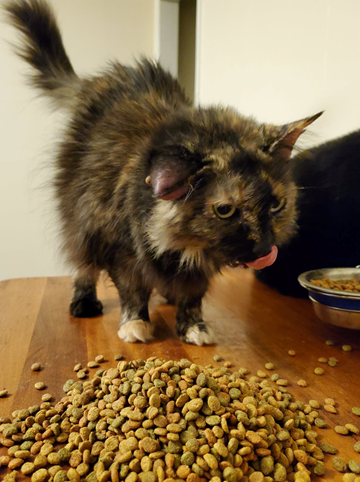Greetings and salutations everyone. For any new people that have not met me, my name is Sabrina. I am here to inform you of something that might not be a common thing in the feline world, but it can occur, and that is cauliflower ear. I and my brother Buddy have both acquired the Perichondral Hematoma AKA (also known as) cauliflower ear. Cauliflower ear is an irreversible deformity caused by the formation of scar tissue and contraction of the perichondrium which occurs after a separation of the ear cartilage from the underlying connective tissue. You may have heard this term before as it is common in boxers, and fighters. The most common causes of trauma are ear infections, ear mites, allergies, foreign body (such as a grass seed), or a direct hit to the pinna.
This post contains affiliate links. We may earn compensation when you click on the links at no additional cost to you.
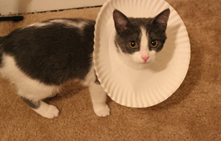
Here is what happened to me. Sadly I have to say this is very painful but not a lot furparents can do for us. The swelling of the ear is what you probably will notice first. Our parents felt very bad for us when they realized this was happening. Cauliflower ear is irreversible and there is no true treatment for it. One option for treatment is ear hematomas may be drained by placing multiple sutures in the ear, then bandaging the ear to prevent further damage, which allows the underlying tissues to re-adhere and avoids the hematoma recurring sometimes. This option is done by your veterinarian and is not a guaranteed fix. It may reoccur. Your cat will be given pain relief for the first 24-48 hours after surgery, and an Elizabethan collar, also known as a cat cone. Our parents learned a paper plate works just as well for the cat cone. The “cone” may be necessary to prevent your cat from scratching the area. Sutures and bandages will be removed 2-3 weeks post-surgery.
The most common way for cats to get cauliflower ear is mites. So, the best preventative is to treat ear mites quickly and seek prompt veterinary attention if the cat develops an ear hematoma. The longer the hematoma is present, the greater the chances of cauliflower ear developing. With, an injured ear draining can be done, but scar tissue will still form. The ear will never regain its original smooth shape.
My brother and I do not, nor ever have had ear mites. Our Perichondral Hematoma was caused by a direct hit to the pinna. Our guess is this was caused by ourselves scratching too hard or caused in a spat from a fight with our siblings. Remember there are 9 of us felines living under 1 roof.
Now for some medical terms and reasons. Let’s break this down real fast. Where does the Perichondral Hematoma start? The Felis catus ear anatomy (do not fret human we only cover what is necessary) starts with the Pinna, which is the outer part of the ear, which acts as a funnel to direct sound further into our ear and is made up of three layers:
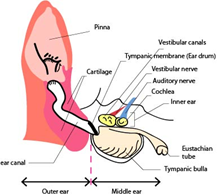
Cartilage plate: is the innermost layer of the pinna which provides the shape and rigidity. Unlike other tissues, the cartilage lacks the ability to heal itself when damaged. Perichondrium: A protective layer of connective tissue that provides the blood supply and nutrients to the cartilage. The underlying cartilage and the overlying skin are both firmly attached to the perichondrium. Skin: The outermost layer of skin which is covered with short hairs on the outside.
As we cats scratch the ear or shake our head, (Head shaking is more common in floppy-eared dogs, but we felines can still do this as well.) the perichondrium separates from the cartilage which creates space. The perichondrium blood vessels rupture and blood pools in the pocket-forming a hematoma. This build-up of blood between the perichondrium and cartilage can interrupt the blood and oxygen supply to the cartilage causing necrosis.
The distortion of the pinna, which becomes hard and cauliflower-shaped (hence the name) is thought to be due to a combination of factors which include myofibroblast contraction of the maturing granulation tissue, excess cartilaginous tissue (preexisting and newly formed), and the separated perichondrium retracts and acts as a bowstring, gradually folding back the cartilage.
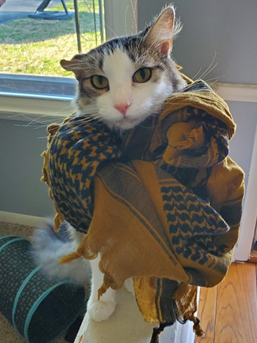
I know all this can seem overwhelming and scary, but that I assure is not my aspiration for this blog. I just want to inform you the reader of everything that we here at Kittystead have experienced and learned.
Here’s another cause that is not as common. Cauliflower ear will cause your furbaby discomfort and could be caused by head shaking and scratching of the ear that can lead to Perichondral Hematoma or simply a minor disagreement with a sibling. That is Otitis externa and essential what Otitis externa is an inflammation of the outer ear canal. There are many possible causes, but the most common is an ear infection caused primarily by bacteria or yeast.
This post contains affiliate links. We may earn compensation when you click on the links at no additional cost to you.
If your cat is scratching incessantly, it’s time to visit your veterinarian. Itchy skin also can be caused by conditions other than allergies, your veterinarian may want to rule out the other potential causes, such as parasites, bacterial or fungal infections, or systemic diseases.
Tests can include a thorough physical examination; evaluation for external parasites such as fleas or mites; skin tests to rule out fungal, yeast, or bacterial infections; and others, such as blood tests and urinalysis, to determine if your pet has a systemic disease. Once your veterinarian determines that your cat has allergies, the next step will be to find out under which category they fall.

Food allergies
Food allergies are common, can affect cats of any age, and represent approximately 10% of all allergic conditions. After performing food trials to determine what ingredient your cat is allergic to, treatment involves feeding a diet that does not contain that ingredient.
Environmental allergies

Another common form of allergy is caused by exposure to environmental allergens that your cat either breathes in or absorbs through the skin. In people terms, we call this “hay fever.” Common allergens include house dust mites; pollen, grasses, and weeds, and a variety of molds. While allergies often give people runny noses, they usually make cats itchy. Your itchy pet may benefit from topical treatment including cool baths, medicated shampoos and conditioners, and soothing sprays. If your cat has mild allergies, he/she may be treated with antihistamines or omega-3 fatty acids. More severe cases may require stronger medications such as prednisone or allergy shots.
Flea allergies
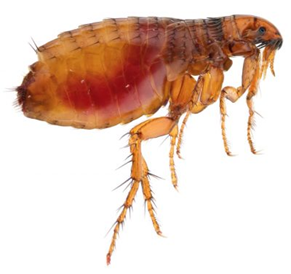
Flea allergy is the most common skin disease in cats (and dogs). It is also called flea bite hypersensitivity because it is caused by an allergic hypersensitivity reaction to flea saliva. Fleas are very common and live both on your pet and in the environment. Our parents do a lot to prevent this one as we have had our fair share of outbreaks. To put this mildly, Dad hates fleas the most as he, himself is allergic to them. If you have 1 pet with fleas, go ahead and assume ALL the pets in a household will be infested and need treatment. In addition to causing allergies in susceptible cats, they can also transmit other diseases.
Treatment for flea allergies involves eliminating fleas from your cat and the environment using products recommended by your veterinarian that are effective against all stages of fleas-from eggs to adults. To control itching your veterinarian might prescribe various medications including antihistamines, omega-3 fatty acids, prednisone, and other medication – NOTE to tell my parents, personally, if it happens again to me just sedate me, I hate itching!!! It is the worst.
While there is no way to prevent allergic dermatitis, treatment is often very effective once the type of allergy has been determined. Check your pet often for fleas and watch for signs such as scratching or excessive grooming. If you suspect your cat may have skin allergies, contact your veterinarian right away. Early diagnosis and treatment will keep your pet’s symptoms from becoming severe.
This post contains affiliate links. We may earn compensation when you click on the links at no additional cost to you.
Thank you for joining us today. I know it was a lot of information and medical terms but I feel as if this is an important topic to bring up to the public eye. Be sure to sign up for Kittystead’s newsletter for tips, tricks, and more to come here on Kittystead.
Until we meet again,
Sabrina


